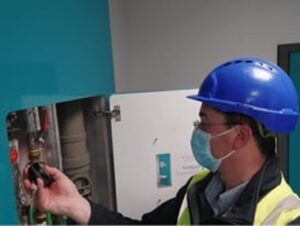legionella
Legionella management: Back to basics (part 2)
SHP hears from Antony Paskin, a Senior Consultant at Water Hygiene Centre on his second article on Legionella management, with a focus on log books, records & dealing with non-compliance.
Have a read of the first article here.
Log Books & Records

Antony Paskin, Senior Consultant at Water Hygiene Center
Where does the need for water hygiene records come from?
The Management of Health and Safety at Work Regulations 1999 requires employers to undertake risk assessments, plan to implement necessary control measures, appoint a competent person(s), and arrange for appropriate training. Each of these basic requirements requires some form of written record and this will form the basis of the site logbook or record keeping system, and whether that be paper-based or electronic in nature the principle remains the same.
The site logbook should contain the following:
- Legionella Risk Assessment
- Water Safety Plan
- Written Scheme of Control
- Records of all monitoring, remedial actions and sampling. These may consist of information provided by internal competent persons but also external service providers.
- Details of all roles and responsibilities and appointments
- Legionella training & competency in the form of a training matrix and copies of competency assessments/appraisals, also include evidence of the competency of external staff.
Paper records should be held in a clear file structure, and this should then be replicated in some way through an organised file structure on a ‘shared’ computer drive if paper records are scanned. Once such a system is in place all relevant staff must be suitably trained in the use of the system so that they can record and retrieve data as required.
Records should be retained for the period in which they remain current and:
- For an added two years for Legionella risk assessments;
- For an added five years for all monitoring and inspection data.
In summary, records are evidence that checks have been undertaken to monitor the performance of a water system. Without records, it is almost impossible to adequately evidence that a task has been completed. Records are a fundamental requirement to demonstrate successful water safety management. The opportunity exists to review each step of the water safety process and ensure adequate detail, information, instruction, reporting, and mitigation is in place.
Dealing with Non-Compliances
 What do we mean by non-compliance issues?
What do we mean by non-compliance issues?
In most cases, we are looking at issues that do not meet guidance, in water hygiene this is ACoP L8 “Legionnaires’ disease. The control of legionella bacteria in water systems”, HSG 274 Parts 1, 2 and 3 “The control of legionella bacteria”, and then the relevant healthcare documents specific to which part of the country you are based ((S)HTM 04-01 or (S)HTM 01-05)
These detail the system conditions that a Responsible Person needs to manage to control the growth of bacteria in buildings’ water systems.
The non-compliances will come from any of the following:
- Remedial actions identified within the Legionella risk assessment(s);
- Routine completion of pre-planned maintenance tasks;
- Poor bacteriological water sample results;
- Or from a water hygiene audit.
Once non-compliance issues have been identified and documented, one of the key things to consider is how to prioritise these.
Do you start with those issues that you’re able to deal with quickly or less costly?
What about looking at the Legionella risk assessment remedial actions over any others?
The correct action is always to look at the people using the building, where are the most susceptible people and what systems can they use and prioritise these actions.
Review these systems, find the highest risk actions identified, and tackle these first. However, if you have carried out Legionella sampling and have water sample results that indicate the presence of harmful bacteria, this shows you have not been able to control the system and the actions to resolve this problem should be tackled right away.
Once you have prioritised the actions then an appropriate timescale should be agreed upon to complete the works. It is important that you create a record of what work was done, when and by whom to ensure that you can demonstrate compliance.
The final step is then to update the written scheme to show that the area of non-compliance originally identified has now been rectified and minimal Legionella risk remains.
Regular audits of the records should take place to ensure that all areas of non-compliance that have been identified have been correctly prioritised, had appropriate actions taken, and that the non-compliance has not been repeated.
Legionella management: Back to basics (part 2)
SHP hears from Antony Paskin, a Senior Consultant at Water Hygiene Centre on his second article for Legionella Management, with a focus on log books, records & dealing with non-compliance.
Safety & Health Practitioner
SHP - Health and Safety News, Legislation, PPE, CPD and Resources Related Topics
EV fleet – are electric cars safe?
Legionella Management: Who can be appointed as RP, DRP, AP or CP?
James Macpherson on risk: ‘More of the same won’t work’


 What do we mean by
What do we mean by